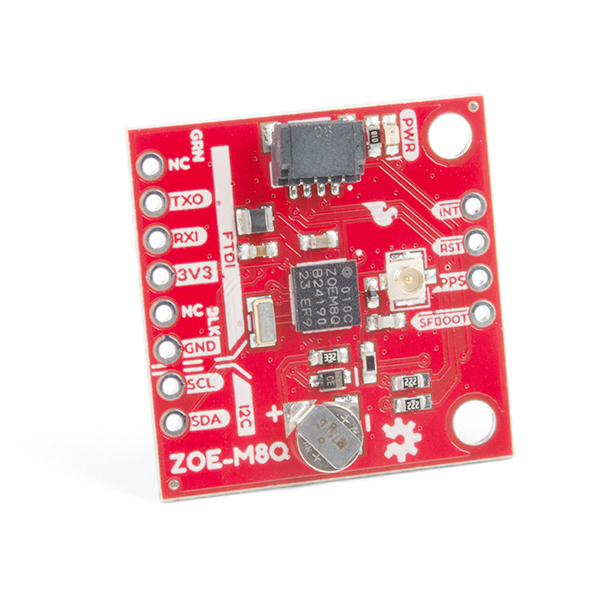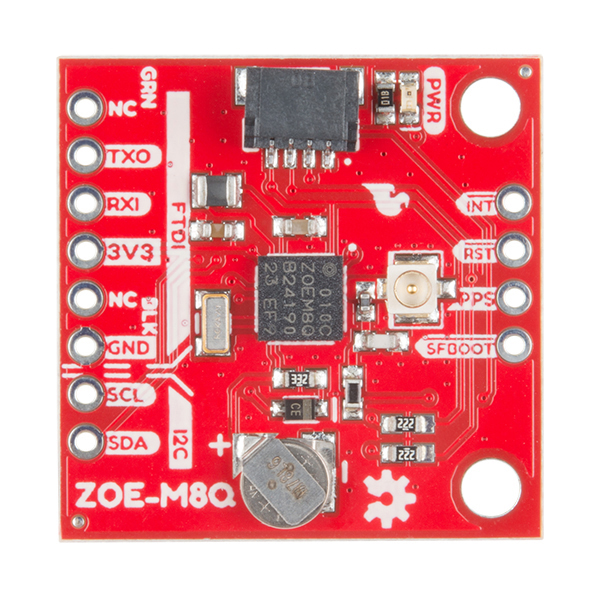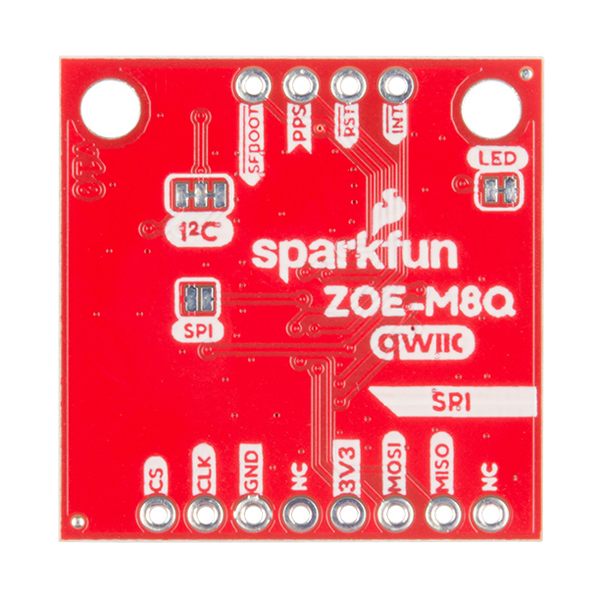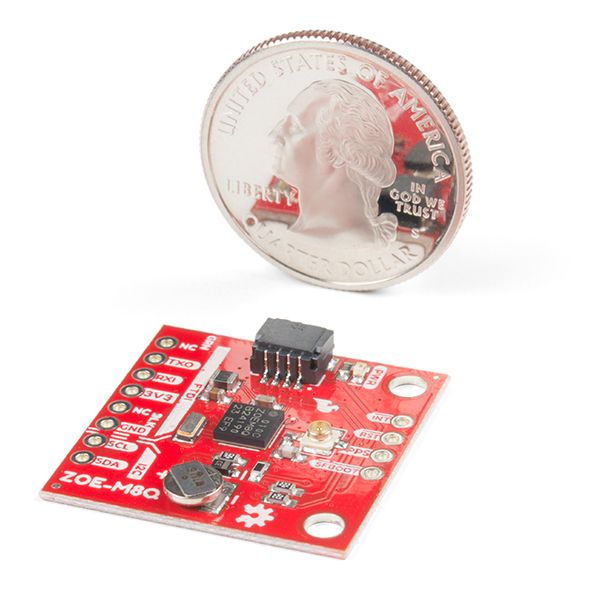SparkFun GPS Breakout - ZOE-M8Q (Qwiic)
The SparkFun ZOE-M8Q GPS Breakout is a high accuracy, miniaturized, GPS board that is perfect for applications that don't possess a lot of space. The on-board ZOE-M8Q is a 72-channel GNSS receiver, meaning it can receive signals from the GPS, GLONASS, BeiDou, and Galileo constellations. This increases precision and decreases lock time and thanks to the onboard rechargable battery you'll have backup power enabling the GPS to get a hot lock within seconds! Additionally, this u-blox receiver supports I2C (u-blox calls this Display Data Channel) which made it perfect for the Qwiic compatibility so we don't have to use up our precious UART ports. Utilizing our handy Qwiic system, no soldering is required to connect it to the rest of your system. However, we still have broken out 0.1"-spaced pins in case you prefer to use a breadboard.
U-blox based GPS products are configurable using the popular, but dense, windows program called u-center. Plenty of different functions can be configured on the ZOE-M8Q: baud rates, update rates, geofencing, spoofing detection, external interrupts, SBAS/D-GPS, etc. All of this can be done within the SparkFun Arduino Library. We've also made sure to configure the UART pin grouping on the breakout to an industry standard to insure that it easily connects to a Serial Basic.
The SparkFun ZOE-M8Q GPS Breakout is also equipped with an on-board rechargeable battery that provides power to the RTC on the ZOE-M8Q. This reduces the time-to-first fix from a cold start (~30s) to a hot start (~1s). The battery will maintain RTC and GNSS orbit data without being connected to power for up to five hours. Since the ZOE-M8Q is a tiny GPS receiver and to minimize its footprint, we've added a U.FL connector to allow the use of both large standard ceramic antennas as well as very small chip scale antennas.
Note: The I2C address of the ZOE-M8Q is 0x42 and is software configurable. A multiplexer/Mux is required to communicate to multiple ZOE-M8Q sensors on a single bus. If you need to use more than one ZOE-M8Q sensor consider using the Qwiic Mux Breakout.
The SparkFun Qwiic Connect System is an ecosystem of I2C sensors, actuators, shields and cables that make prototyping faster and less prone to error. All Qwiic-enabled boards use a common 1mm pitch, 4-pin JST connector. This reduces the amount of required PCB space, and polarized connections mean you can’t hook it up wrong.
The ZOE-M8Q GPS Breakout can also be automatically detected, scanned, configured, and logged using the OpenLog Artemis datalogger system. No programming, soldering, or setup required!
- 72-Channel GNSS Receiver
- 2.5m Horizontal Accuracy
- 18Hz Max Update Rate
- Time-To-First-Fix:
- Cold: 26s
- Hot: 1s
- Max Altitude: 50,000m
- Max G: ≤4
- Max Velocity: 500m/s
- Velocity Accuracy: 0.05m/s
- Heading Accuracy: 0.3 degrees
- Time Pulse Accuracy: 30ns
- 3.3V VCC and I/O
- Current Consumption: ~29mA Tracking GPS+GLONASS
- Software Configurable
- Geofencing
- Odometer
- Spoofing Detection
- External Interrupt
- Pin Control
- Low Power Mode
- Many others!
- Supports NMEA, UBX, and RTCM protocols over UART or I2C interfaces
SparkFun GPS Breakout - ZOE-M8Q (Qwiic) Product Help and Resources
Three Quick Tips About Using U.FL
December 28, 2018
Quick tips regarding how to connect, protect, and disconnect U.FL connectors.
SparkFun GPS Breakout (ZOE-M8Q and SAM-M8Q) Hookup Guide
April 4, 2019
The SparkFun ZOE-M8Q and SAM-M8Q are two similarly powerful GPS units but with different project applications. We'll compare both chips before getting each up and running.
GNSS Chip Antenna Hookup Guide
April 4, 2019
You've always wanted to experiment with those tiny GPS antennas. Now you can!
How to Upgrade Firmware of a u-blox GNSS Receiver
March 26, 2021
A few steps and you'll upgrade to the latest features on a u-blox GNSS receiver.
Getting Started with U-Center for u-blox
September 13, 2018
Learn the tips and tricks to use the u-blox software tool to configure your GPS receiver.
GPS Basics
December 14, 2012
The Global Positioning System (GPS) is an engineering marvel that we all have access to for a relatively low cost and no subscription fee. With the correct hardware and minimal effort, you can determine your position and time almost anywhere on the globe.
Core Skill: Programming
If a board needs code or communicates somehow, you're going to need to know how to program or interface with it. The programming skill is all about communication and code.
Skill Level: Rookie - You will need a better fundamental understand of what code is, and how it works. You will be using beginner-level software and development tools like Arduino. You will be dealing directly with code, but numerous examples and libraries are available. Sensors or shields will communicate with serial or TTL.
See all skill levels
Core Skill: Electrical Prototyping
If it requires power, you need to know how much, what all the pins do, and how to hook it up. You may need to reference datasheets, schematics, and know the ins and outs of electronics.
Skill Level: Noob - You don't need to reference a datasheet, but you will need to know basic power requirements.
See all skill levels
Comments
Looking for answers to technical questions?
We welcome your comments and suggestions below. However, if you are looking for solutions to technical questions please see our Technical Assistance page.
Customer Reviews
4.8 out of 5
Based on 8 ratings:
tinyest GPS module ever
This is a unbelievably tiny GPS / GNSS module. It works like a charm with either passive or active antennas. Make sure you also buy an antenna and matching u.fl adapter. I have used Sparkfuns matching Arduino library and it's really easy to integrate using Qwicc/I2C.
Solid, flexible, GPS Module
A nice, compact, external antenna, GPS module. I am very happy with it. Be aware that it is putting 3.3V on the RF in pin and just ensure that whatever you have upstream either uses the 3.3V to power an active antenna or is DC blocked.
Easy to interface with a microcontroller. I have only used the default sentences, but will next use the ublox specific sentences.
Works pretty well
I've tested in usart mode and showed a really good behaviour. Very sensible with simple dipole of course better with a preamplifier antenna but passive one I good enough for country operation.
Like it
It gives me 1.7m CEP accuracy. Easy to interface with a Redboard Qwiic. Spark fun uBlox code supports all the calls I need.
Negative: Sparkfun uBlox code consumes 82% of the Redboard memory space. I've been able to comment out 3% of functionality I don't need but it leaves little space for other code.
Great GPS / GNSS receiver
Not all GNSS receivers are the same, and this one is great.
I had lots of issues with other "Ultimate GPS Breakout" boards due to poor quality of the receiver: bad time/position reported, random resets, unstable positioning. This u-blox is super solid in my use case.
A small bonus is that the RMC sentence is the first thing to come through the UART port every second, which is all I need.
ZOE-M8Q (Qwiic)
Hi, Tx, for asking. I did try to use it very much the same as I am using my ZED-F9P gps in conjunction with ESP32-WROM-32 connecting via the Qwiic connection and the same library "SparkFun_u-blox_GNSS_v3.h". The board will not communicate.
Tx,
Beni.





Hello, when developing a library for a FreeRTOS project, I connected a logic analyzer to the I2C channel to sniff the data when connected to Arduino Uno. One day, the GNSS chip got extremely hot and stopped working; this has happened to two boards, and I don't know why. Any feedback would be appreciated.